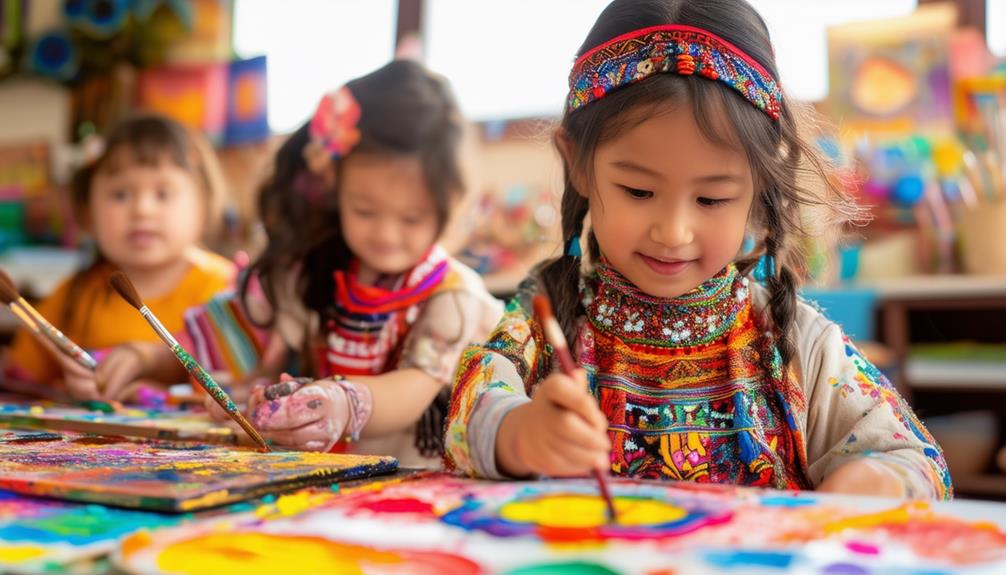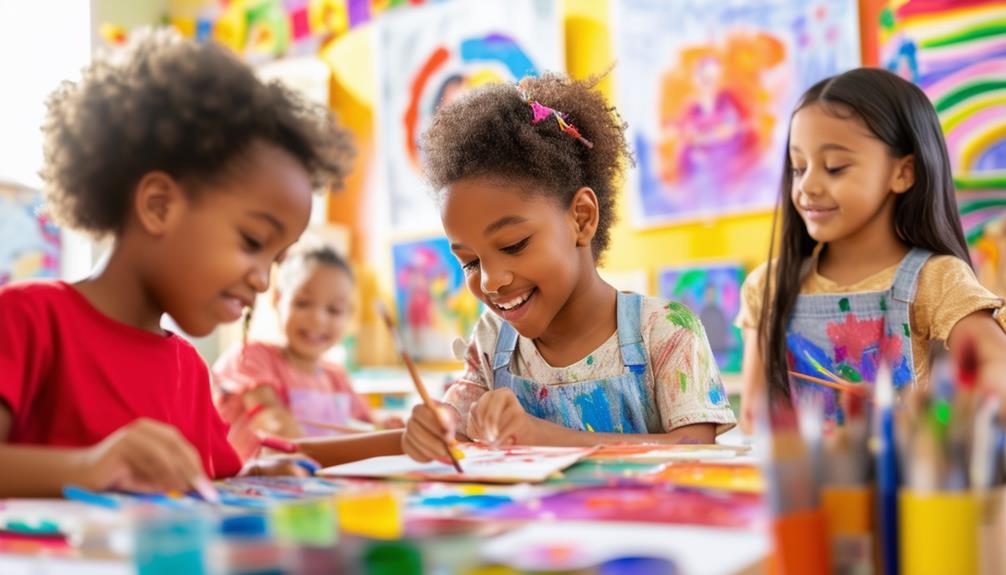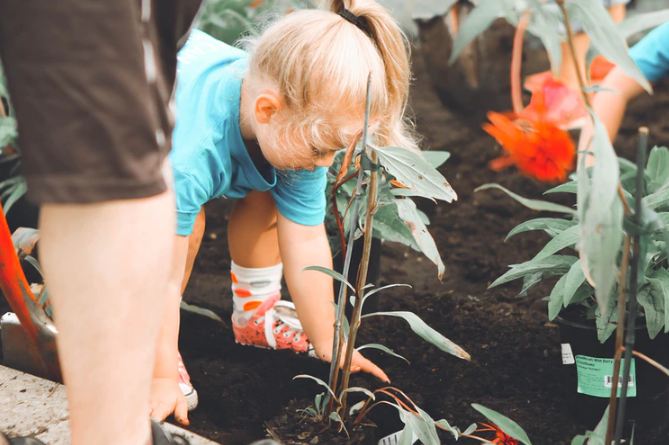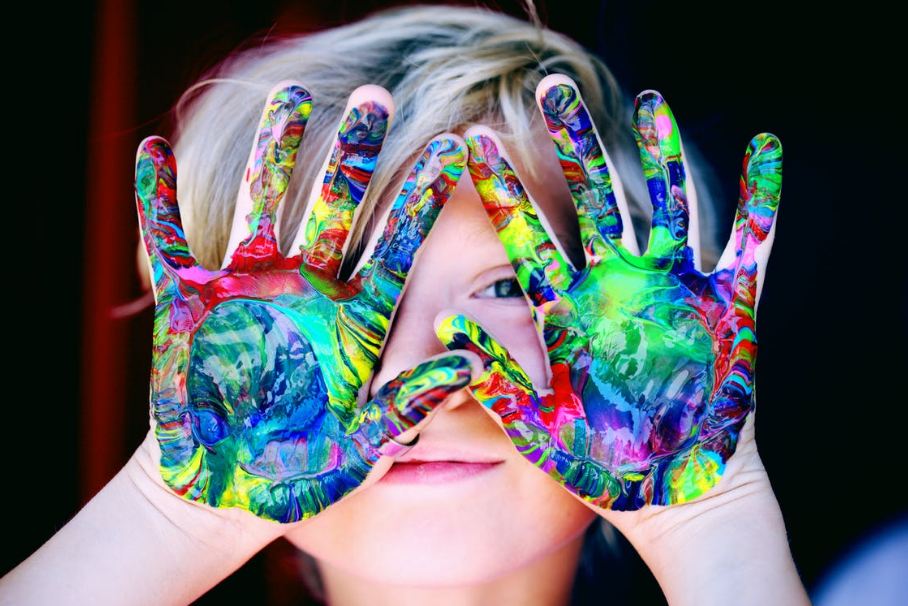Using Painting to Teach Kids About Cultural Traditions

Using painting to teach kids about cultural traditions creates a dynamic and engaging learning experience. By guiding children to create art inspired by traditional motifs and symbols, educators can spark curiosity about diverse heritages. This method nurtures empathy and respect, promoting inclusive conversations about global customs. Painting activities can be easily integrated into various educational settings, making learning enjoyable and enlightening. How can educators effectively use this creative approach to broaden young minds and foster a deeper understanding of cultural diversity?
Cultural Crafts
Immerse yourself in the vibrant world of cultural artistry, where creative expressions narrate the rich stories of history, traditions, and beliefs. From the detailed beadwork of the Maasai in Africa to the intricate paper-cutting techniques of China, these art forms provide a glimpse into the heart of different cultures. Each crafted piece reflects the unique traits and heritage of its region, transforming basic materials into profound expressions of identity.
Engaging with these art projects means not only creating art but also connecting with traditions passed down through generations. These skills are crucial for preserving cultural heritage, ensuring that the stories and techniques of the past are not forgotten. By learning and teaching these art forms, you play a vital role in keeping these traditions alive.
Different cultures bring their own unique touch to craftsmanship, showcasing distinct styles and techniques that highlight their diverse backgrounds. Whether through weaving, carving, or sculpting, each art project encapsulates the essence of its origin. Immerse yourself in the rich tapestry of global artistry and explore how each culture's unique approach to crafts can inspire and educate, making the past resonate with the present.
Craft Materials
Exploring craft materials opens up a world of creativity and cultural history. Each region employs unique materials and techniques—ranging from wood and clay to feathers and leather—that reflect local traditions. Understanding these diverse materials allows you to appreciate the skill and artistry behind each piece.
Diverse Crafting Materials
When teaching kids about cultural traditions, exploring diverse crafting materials like fibers, textiles, and clay can provide them with a hands-on understanding of varied artistic techniques and cultural expressions. Craft styles and techniques from around the world often rely on a wide range of materials and methods. For example, weaving fibers for baskets or creating intricate macrame can teach kids about the patience and skill required in different cultures.
Fibers and textiles are essential for understanding global textile traditions. Kids can learn how various cultures use these materials to create unique patterns and designs, often imbued with significant cultural meanings. Working with clay introduces them to pottery techniques passed down through generations, showcasing the importance of craftsmanship.
Materials like wood, metal, and glass also offer insights into diverse craft styles. Carving wood or shaping metal and glass can help kids appreciate the detailed work and cultural significance behind these crafts. Feathers and leather, used in many indigenous cultures, highlight the connection between natural materials and artistic expression.
Regional Artistic Techniques
Exploring regional artistic techniques introduces children to the diverse ways different cultures use materials to create distinctive and meaningful art. Immersing oneself in these methods reveals a variety of materials such as fiber, fabric, wood, clay, metal, and glass. Each region has unique styles and approaches that reflect its resources and traditions. For instance, some cultures incorporate feathers and leather into their crafts, producing intricate designs that hold both beauty and cultural significance.
In many regions, these artisanal methods are passed down through generations, ensuring the continuity of cultural craftsmanship. Introducing children to these practices fosters an appreciation for the skill and artistry involved in working with diverse materials.
Neglecting to preserve these skills can lead to the loss of cultural styles, making it crucial to maintain and celebrate regional artistic techniques. Teaching children about these traditional methods helps keep these cultural expressions vibrant and relevant, connecting them with the rich histories and artistic heritage of different communities.
Celebrating Cultural Differences

Celebrating cultural differences through art fosters cultural awareness in your classroom. By encouraging children to create paintings that reflect diverse traditions, you help them embrace diversity. This approach not only promotes inclusivity but also cultivates a more understanding and accepting environment.
Fostering Cultural Awareness
Teaching kids about cultural traditions through painting can ignite their interest in and appreciation for diverse backgrounds. When children engage in painting, they learn about various cultural symbols and practices, which helps them understand the richness and uniqueness of different heritages. By incorporating traditional motifs and stories into their artwork, kids can explore and express the beauty of cultures different from their own.
Painting serves as a powerful tool to foster cultural awareness. It encourages empathy by helping children see the world from multiple perspectives. As they participate in painting activities focused on cultural traditions, kids develop a deeper respect for others. They begin to realize that every culture has its own special customs and history worth celebrating.
Encouraging children to paint cultural themes also promotes inclusivity and unity. When kids share their paintings, they create opportunities for discussions about the different traditions represented in their artwork. This exchange of ideas can build a more inclusive environment where everyone feels valued and understood.
Embracing Diversity Through Art
Art can be a vibrant gateway for children to appreciate and celebrate cultural diversity. By introducing students to various cultural traditions, symbols, and artistic expressions from around the world, educators enable them to discover the rich tapestry of human experience. Art serves as a powerful tool to foster acceptance and understanding among children.
When students engage in art projects that reflect diverse cultures, they begin to develop empathy and respect for different perspectives. Through art, you can tell stories from various cultures, allowing children to express their unique emotions, experiences, and identities. This not only promotes inclusivity but also builds a sense of community among the students.
As an educator, you play a crucial role in this process. By introducing diverse art materials and facilitating collaborative projects, you create an environment where students feel encouraged to explore and appreciate cultural diversity. These activities help children see the beauty in differences and understand the importance of acceptance.
Ultimately, embracing diversity through art enriches students' lives, teaching them to value and respect the myriad ways people express themselves. It is a powerful method for cultivating a more inclusive and empathetic future.
Promoting Inclusive Classrooms
In an inclusive classroom, promoting acceptance and appreciation of cultural differences can be achieved by encouraging students to share their unique traditions and backgrounds. Using art to teach about these diverse customs fosters an environment that celebrates every student's heritage. Here are effective strategies to foster inclusivity through art:
- Collaborative Murals: Have students work together on a mural that incorporates cultural symbols and traditions from various backgrounds. This serves as a visual representation of the classroom's diversity.
- Cultural Art Projects: Assign art projects that highlight traditional art forms from different cultures. Students can create Mexican folk art, African masks, or Japanese origami, among others.
- Storytelling through Art: Encourage students to illustrate stories from their cultural backgrounds. This activity not only enhances their understanding of each other's customs but also develops their storytelling skills.
- Cultural Art Exhibitions: Organize exhibitions where students display their culturally inspired artwork. Invite parents and community members to celebrate the diverse traditions showcased.
Art as a Universal Language
Imagine a world where children from diverse cultures connect effortlessly through the vibrant strokes of a paintbrush. Art serves as a universal language that transcends cultural, linguistic, and physical boundaries, enabling kids to communicate and bond over shared creativity. Through art projects, children can explore and express diverse cultural symbols and traditions, fostering a deeper appreciation for global diversity.
One effective way to harness this universal language is through art exchange programs. By participating in these exchanges, students from different parts of the world can share their paintings, offering glimpses into their unique cultural backgrounds. This exchange not only broadens their artistic horizons but also strengthens their sense of global community.
Here's how art can bridge cultural gaps:
| Activity | Cultural Impact |
|---|---|
| Art Projects | Exposure to varied symbols |
| Art Exchange | Shared cultural insights |
| Collaborative Work | Global creativity network |
Creativity in art breaks down barriers, allowing children to understand and appreciate different artistic expressions. By engaging in collaborative art projects and exchanges, they can communicate their experiences and perspectives, creating a shared language of creativity that connects them beyond words. Painting becomes a powerful tool for cultural understanding and unity.
Fostering Empathy

Painting offers children a unique way to step into someone else's shoes and develop a deep sense of empathy for diverse cultural experiences. Beyond colors and creativity, painting becomes a medium for understanding and appreciating a range of perspectives. When kids paint stories, emotions, and traditions from different cultures, they begin to see the world through varied lenses, fostering compassion and understanding toward cultural differences.
Here are steps to encourage empathy in children through painting:
- Explore Different Cultures: Introduce kids to paintings and artistic styles from various cultural backgrounds. Discuss the stories and emotions behind these artworks to deepen their understanding.
- Create Cultural Art Projects: Assign painting projects with cultural themes, such as scenes from diverse cultural festivals or historical events, to broaden their perspectives.
- Share Personal Stories: Encourage kids to paint something meaningful from their own cultural heritage and share the story behind it. This practice helps them appreciate both their own background and those of others.
- Discuss Emotions: Engage in conversations about the emotions depicted in their paintings. This helps children empathize with the feelings and experiences of individuals from varied cultural backgrounds.
Role of Educators
Educators have a unique opportunity to shape young minds by introducing them to the rich tapestry of cultural traditions through art. By incorporating diverse art materials into lessons, educators can promote cultural awareness and acceptance among children. Facilitating collaborative art projects not only teaches various artistic techniques but also encourages meaningful dialogue about diversity and inclusion.
Engaging students in discussions about artworks and their cultural significance creates a supportive environment where embracing differences becomes second nature. Art themes can spark conversations about acceptance, allowing children to appreciate diverse perspectives and experiences. This approach broadens their understanding and fosters a sense of belonging for every student.
Providing children with opportunities to express their own stories and experiences through art is essential. It teaches them the importance of acceptance and self-appreciation. When students see their narratives valued in the classroom, they are more likely to respect and value the stories of others.
In essence, the role of an educator extends beyond teaching art techniques. By integrating cultural lessons into projects and lessons, educators nurture empathy, acceptance, and a lifelong appreciation for diversity.




